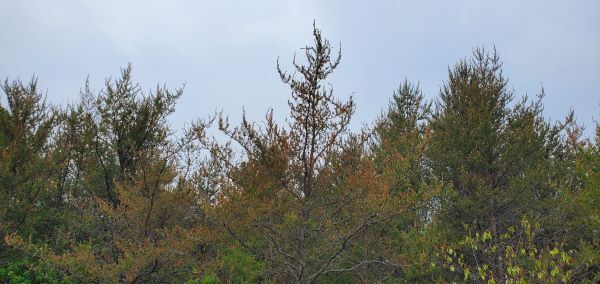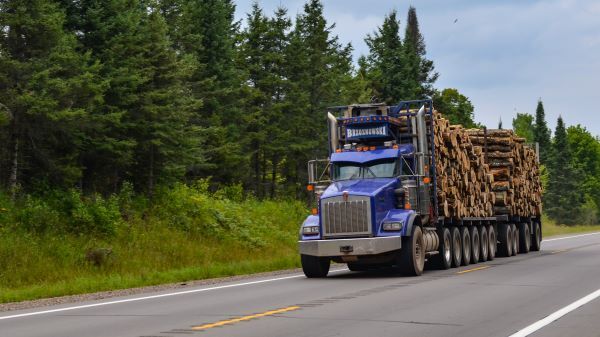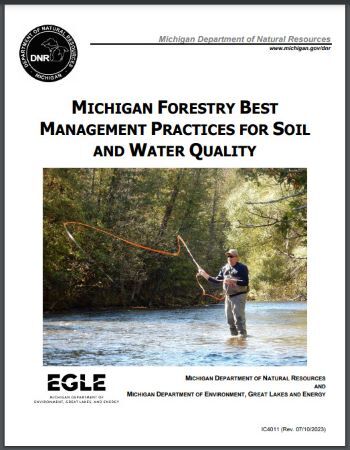|
This twice-yearly newsletter from the Michigan Department of Natural Resources Forest Utilization and Marketing Program shares information on DNR programs, economic reports, industry news, professional development opportunities and more. If you know of an event or opportunity that may be of interest to our partners or have questions, email Brenda Haskill, forest marketing and outreach specialist, or visit us on the web.
In this edition:
 Jack pine budworm defoliation has been reported in areas of the northern Lower Peninsula. During aerial surveys, damage was mapped in Alcona, Alpena, Clare, Crawford, Kalkaska, Montmorency, Ogemaw, Oscoda, Otsego and Roscommon counties. Aerial surveys are ongoing in other areas.
In the Upper Peninsula, reports and observations of defoliation have been limited; however, some defoliation has been reported in northern Wisconsin.
Periodic outbreaks of the native budworm occur every six-12 years and are a part of the natural cycle associated with maturing jack pine. Outbreaks typically last two to four years. The last outbreak was in 2015. The current outbreak began building last year with 28,000 acres of defoliation mapped.

Mature to overmature jack pine stands can be severely damaged. Tree mortality may result from severe defoliation. Wait to evaluate affected stands until red needles have fallen. If few green needles remain, salvage sales should be considered. Dead trees represent a fire risk and will rapidly lose value.
Generally, jack pine stands should be harvested as they mature and become vulnerable. Additional information, including long-term management considerations, can be found in a guide produced by Michigan State University Extension and the USDA Forest Service.
Contact DNR Forest Health Program staff with reports, questions or other assistance needs at DNR-FRD-Forest-Health@Michigan.gov.
|
 A review of wood market conditions across the upper Midwest and northeastern region of the United States reveals that Michigan is not alone in its current slow wood markets. Analysis of the situation brings mixed messages, but what is certain is that here in Michigan, we are seeing fewer shipments of wood products on the highways this summer. Wood-using mills have reported cutbacks in purchases from the logging sector, and orders for finished products are slow for a range of species. Large mills selling finished products on the global market have reported reductions in orders, and many are only producing finished products to meet existing orders. Situations similar to Michigan's markets are being reported in Maine.
To get more market information, join the Forest Markets News Week circulation list provided by the National Association of State Foresters; send an email request to Rick Cantrell to be added to the list.
Data from the research shows different forms of electric power generation, including wind, solar, wood and hydroelectric.
Michigan DNR Forest Economist Jagdish Poudel, MSU Forest Economist Raju Pokharel, Wisconsin DNR Forest Economist Ram Dahal and Shivan GC, Department of Forestry at MSU, launched a study on the availability and economic contribution of forest biomass in the Lake States of Michigan, Minnesota and Wisconsin. Their academic report is now available in the Oxford Academic Journal of Forestry. Read the report: Forest Biomass Feedstock Availability and Economic Contribution of Biopower Facilities in the Lake States Region.
 Workers gather for a photo with the first board produced at the converted Sagola facility - via PR Newswire
The LP Building Solutions facility in Sagola has produced oriented strand board for more than 20 years. The mill recently received updates to convert the facility to create LP SmartSide board to keep up with growing demands for the siding product line.
At full capacity, LP Sagola will be able to produce approximately 330 million square feet of SmartSide siding annually, bringing the company's total siding production capacity to approximately 2.3 billion square feet.
An urban wood utilization event in Ann Arbor shows boards made from city trees
Michigan is one of eight states that are part of the Urban Wood Network, a national coalition of urban wood industry professionals and stakeholders. Urban wood includes lumber produced from fresh-cut urban trees and material from demolished buildings and other salvaged lumber. Rescuing wood from the waste stream is a way to reuse what might otherwise end up in a landfill or chipped for mulch. A Great Lakes Echo piece explores how programs promoting the use of urban wood have ignited in recent years.
The U.S. Department of Agriculture has awarded more than $43 million to expand innovative uses of wood in construction, energy, manufacturing and more. Four awardees provided with USDA Wood Innovations Grants are from Michigan.
|
Applicant - project title
|
Funding
|
|
Manthei Wood Products - Manthei Wood-Fired Boiler
|
$300,000
|
|
Northern Hardwoods Lumber, LLC - Northern Hardwoods Biomass Boiler and Energy System
|
$1,000,000
|
|
Shamco Lumber, Inc. - Shamco Lumber Mill and Market Expansion
|
$300,000
|
|
Michigan State University - Strategic Outreach, Engagement, and Technical Assistance: Expanding and Diversifying the Michigan Mass Timber Ecosystem to Increase Demand and Support Production
|
$299,929
|
Sarnia, Canada, is now home to a commercial plant that will make materials for "green plastics" out of woodchips, the first of its kind in the world.
Origin Materials will begin producing chloromethylfurfural, known as CMF, on Aug. 19.
The Sarnia plant will use technology that converts biomass such as wood chips and sawdust to CMF. The CMF can be used to make products such as clothing, textiles, plastics, packaging, car parts, tires, carpeting, toys and fuels that are carbon negative or neutral and fully recyclable.
 The USDA Forest Service has awarded more than $824,000 from the federal Bipartisan Infrastructure Law to the Alliance for Green Heat to expand firewood banks. Firewood banks are much like food banks – they serve low-income communities that struggle with high heating costs. Firewood banks, often run by churches, towns, tribes and volunteer groups, may receive donated logs to turn into split, seasoned firewood or purchase truckloads of firewood for distribution. Firewood bank applications can be submitted starting Sept. 1. More information is available from the Alliance for Green Heat.
A funding opportunity to expand renewable energy and biomass projects is available through the Powering Affordable Clean Energy Act; letters of interest will be accepted through Sept. 29. Webinars and office hours will provide further information. Learn more about PACE funding.
Under PACE, the USDA Rural Development’s Rural Utilities Service will forgive up to 60% of loans for renewable energy projects that use wind, solar, hydropower, geothermal or biomass, as well as for renewable energy storage projects.
The PACE program is part of the federal Inflation Reduction Act. The goal of PACE is to make clean, affordable and reliable energy accessible to Americans living in rural areas.

The DNR is reprinting copies of the Forestry BMP guide titled "Michigan Forestry Best Management Practices for Soil and Water Quality" with some small updates.
If you have a 2018 print copy of the Best Management Practices, hang on to it – management guidance is still accurate. The latest edition of the guide corrects broken web links, updates state administration data and changes references to the Department of Environmental Quality to the Department of Environment, Great Lakes, and Energy.
Limited numbers of hard copies will be available at upcoming SFI® logger trainings and Society of American Foresters meetings. They are also available by contacting Margaret Spagnuolo or Mike Smalligan.
View and download the Michigan Forestry Best Management Practices for Soil and Water Quality. Find more forest management information at Michigan.gov/ForestManagement.
|
|